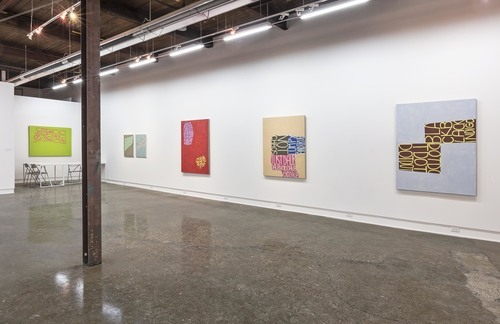Twilight Hour, an inspiring conversation with Allyson Clay
by Jamie Chen

Sight of Allyson Clay’s One Possible Arrangement exhibition at Katzman Contemporary, February 20 to March 22, 2014. (Image source: Katzman Contemporary’s website)
Twilight Hour has become a traditional artist talk of the Painting Department. Artists are invited to share their inspiring thoughts and talk about their working process, which is very helpful to art students still exploring answers to their own art practices.
During the talk, the artist’s presentation always focuses on things like “How to develop ones’ own style?”, “How to find one’s style?”, and “What transition an artist sharing a similar style has been through?”, among other questions. These considerations are crucial in the development of an art student; as their experiences provide valuable information. Our minds are opened by different ways of thinking or unusual manners in which a material has been used. These conversations evoke reflection in our own works. As students, we are forced to think in a larger picture and learn to direct our career toward being an independent artist rather than just finishing one project.
This week, Canadian artist Allyson Clay was invited to join this conversation and share her inspiring art practice with us. Allyson Clay has a BFA in Painting from the Nova Scotia College of Art and Design and a MFA in Painting from the University of British Columbia, Vancouver. Her art practice covers several mediums, including photography, video, and painting. She has also exhibited internationally.
The style of Clay’s works tends mainly towards the conceptual and abstraction. The concept of the work is given greater attention than the end result, which leads to simplification of its visual enjoyment. A process of knowing and thinking is attached to the experience of reading the art piece rather than just the immediate sensory experience. I find this process is more like reading and learning, which has a chronicle impact on the viewer. In her work, Clay always involves text or books, which represents logical thinking and rationality. During her talk, she revealed her passion for reading philosophy, poetry, and writing, and so she always includes written elements in her work, which is inventive in drawn and painted work.
Groundsplatpink, her most recent series of paintings, is another successful example of the combination of text and image. There she brings together painting’s and writing’s creative processes, and combines their most effective functions in art practice. Through her text paintings she brings abstraction out of its awkward conversation with the viewer, providing more communicative elements in the work. It makes the abstract work more efficient as visual communication.
Clay has found a perfect balance between sensation and the conceptual, the visual and the abstract. She uses color combinations and visual elements together with abstract elements, like geometric graphs and texts, to create a mixture of sensory and rational experience. Her Mazes painting series is a good example of this balance in her work.
Clay’s endless experimentation and exploration of the possibilities of abstract art is worth looking up to. Just like designers search for better solutions for product design, artists also search for better solutions for communication, either in an abstract or realistic style.

 Rosalie Mills (left) and Julie Mills (right) from the Folk N’ Rap Show.
Rosalie Mills (left) and Julie Mills (right) from the Folk N’ Rap Show.









